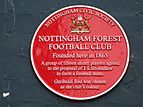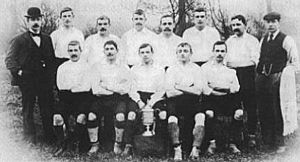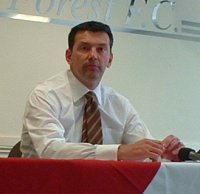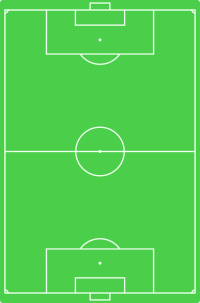Nottingham Forest F.C. facts for kids
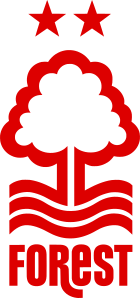 |
||||
| Full name | Nottingham Forest Football Club | |||
|---|---|---|---|---|
| Nickname(s) |
|
|||
| Short name | Nott'm Forest | |||
| Founded | 1865 | |||
| Ground | City Ground | |||
| Capacity | 30,332 | |||
| Owner | Evangelos Marinakis | |||
| Chairman | Tom Cartledge | |||
| Manager | Nuno Espírito Santo | |||
| League | Championship | |||
| 2018–19 | Championship, 9th of 24 | |||
|
||||
Nottingham Forest Football Club is a professional football team from Nottingham, England. They play in the Premier League, which is the top football league in England.
The club was started in 1865. Since 1898, Forest has played its home games at the City Ground. Nottingham Forest is famous for winning the European Cup twice in a row. Only five other English clubs have won this important trophy.
They have also won the UEFA Super Cup, one league title, two FA Cups, and four League Cups. The club's most successful time was in the late 1970s and early 1980s. This was when Brian Clough and Peter Taylor were in charge.
In the 1980s and 1990s, Forest won more League Cups. They also reached the 1991 FA Cup final but were relegated from the Premier League in 1993. After returning to the Premier League in 1995, they were relegated again in 1997 and 1999. In 2022, Forest made it back to the Premier League by winning the play-offs.
Forest's biggest rival is Derby County. Their matches are called the East Midlands derby. They play for the Brian Clough Trophy. Forest has won more of these games and has the longest unbeaten run against Derby.
Contents
History of Nottingham Forest
How Nottingham Forest Started (1800s)
In 1865, some friends who played a sport called shinty met in a pub called the Clinton Arms. They decided to start a football club instead. This is how Nottingham Forest Football Club began. They chose 'Garibaldi Red' as their official colour. This colour was named after an Italian hero. They bought red caps with tassels, making them one of the first clubs to wear red.
The club's name, 'Forest', likely comes from the Forest Racecourse, where they first played. Nottingham Forest is one of the oldest clubs in the English Football League. Some people say they are the oldest.
Forest's first official game was against Notts County on March 22, 1866. In their early days, Forest helped other famous clubs get started. In 1886, they gave Arsenal a set of red kits. Arsenal still wears red today because of this! Forest also helped Everton and Brighton & Hove Albion.
Forest first played in the FA Cup in 1878–79. They won the Football Alliance in 1892 before joining the Football League. In 1898, Forest won their first FA Cup by beating Derby County 3–1 in the final. This was a big surprise because Derby was a much stronger team.
Early 1900s: Ups and Downs
After their FA Cup win, Forest had some good seasons. But then they started to struggle. They were relegated (moved down a league) in 1906. They got promoted right back up in 1907 but were relegated again in 1911. The club faced serious money problems before World War I. Luckily, the war and help from club members kept them going.
In 1919, the top league expanded. Forest tried to join but didn't get enough votes. They were promoted to the top league in 1922 but were relegated again in 1925. They stayed in the second tier until 1949, when they dropped to the third division.
Coming Back and Then Struggling (1950–1974)
Forest quickly got promoted back to the second division in 1951. They scored a record 110 goals that season! In 1957, they returned to the top league.
In 1959, Forest won their second FA Cup. They beat Luton Town 2–1 in the final. Just like in 1898, they had lost badly to the same team in the league just weeks before. Forest had a great start, scoring two goals early. But their player Roy Dwight broke his leg, and Luton fought back. Forest held on to win 2–1.
In the 1966-67 season, Forest almost won the league title. They finished second and reached the FA Cup semi-final. This seemed like a chance to build a great team. But instead, the club started to decline. Forest was relegated from the top league in 1972.
The Brian Clough and Peter Taylor Era (1975–1982)
Brian Clough became Forest's manager in January 1975. He brought his trainer, Jimmy Gordon, with him. Clough also signed some key players like John McGovern and John O'Hare. He helped young players like John Robertson and Viv Anderson become stars.
In July 1976, Peter Taylor joined Clough as his assistant. Taylor was great at finding new talent. He helped Robertson get fit and turn Tony Woodcock into an England striker. Taylor also signed Peter Withe and Garry Birtles, who both played for England.
Clough and Taylor quickly made Forest a top team. They won the 1976–77 Anglo-Scottish Cup in 1976. In 1977, Forest won promotion to the top league. Taylor then signed Kenny Burns and Peter Shilton, who became key players.
In their first season back in the top league (1977–78), Forest did something amazing. They won the First Division title! They only lost one game all season after November. They also beat Liverpool to win the League Cup.
The next season (1978–79), Forest continued their success. They started with a huge 5–0 win in the Charity Shield. They then beat Liverpool in the European Cup. Forest also set a record by going 42 league games without losing. This record stood until 2004.
In February 1979, Forest made history by signing Trevor Francis for £1 million, a record fee at the time. Francis scored the winning goal in the 1979 European Cup Final as Forest beat Malmö 1–0. They also won the League Cup again, beating Southampton 3–2.
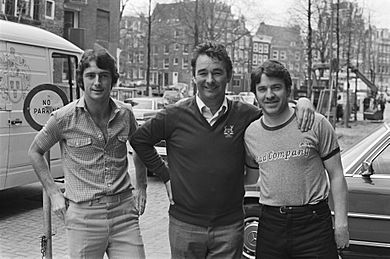
In 1980, Forest won the European Cup for the second year in a row! They beat Hamburg 1–0 in the final. This was an incredible achievement for the club. They also won the European Super Cup against Barcelona. However, they lost the League Cup final to Wolves.
After these amazing years, the team started to change. Key players were sold, and Peter Taylor retired in 1982.
Clough Continues (1982–1993)
Brian Clough stayed as manager. In 1984, Forest lost in the UEFA Cup semi-finals to Anderlecht. Years later, it was found that the referee had received money from Anderlecht.
In 1988, Forest won the Football League Centenary Tournament. They also finished third in the league. In 1989, Clough famously hit two of his own team's fans during a pitch invasion. He was fined and banned from the touchline.
Forest won the League Cup in 1989 and again in 1990. They were hoping for more success, but then the Hillsborough disaster happened. This was a terrible tragedy where many Liverpool fans died at an FA Cup semi-final between Forest and Liverpool. The match was stopped. When it was replayed, Forest lost.
In 1991, Brian Clough reached his only FA Cup final. Forest lost 2–1 to Tottenham Hotspur. In 1992, they lost another League Cup final to Manchester United. This meant Forest had played in seven cup finals in five seasons, winning five of them.
In 1992, Forest joined the new FA Premier League. But they struggled, and Brian Clough's 18-year time as manager ended in May 1993 when Forest was relegated.
After Clough: A Rollercoaster (1993–2017)
Frank Clark, a player from Forest's 1979 European Cup winning team, became manager in 1993. He quickly led Forest back to the Premier League in 1994. In 1995, Forest finished third in the Premier League and played in the UEFA Cup. They reached the quarter-finals, which was the furthest any English team went that season.
But then, key player Stan Collymore was sold. Forest struggled and Clark left in 1996. Stuart Pearce became player-manager for a short time. Then Dave Bassett took over. Forest was relegated in 1997 but won promotion back to the Premier League in 1998. However, they were relegated again in 1999.
For many years, Forest stayed outside the top league. They faced big debts and struggled to sign new players. They had many different managers. In 2005, Forest was relegated to the third division, which was a sad moment for a club that had won the European Cup.
In 2008, under manager Colin Calderwood, Forest won promotion back to the second tier. They were just one step away from the Premier League. Billy Davies then became manager and led Forest to the play-offs twice, in 2010 and 2011. But they lost both times, missing out on promotion.
In 2012, the Al-Hasawi family from Kuwait bought the club. They changed managers very often, which made things difficult. Stuart Pearce returned as manager in 2014 but was replaced by Dougie Freedman in 2015. Forest continued to struggle in the Championship.
New Owners and Premier League Return (2017–Present)
In May 2017, Evangelos Marinakis became the new owner of Nottingham Forest. He wanted to bring the club back to European football. There were more manager changes, including Aitor Karanka and Martin O'Neill.
In 2021, the club made some big changes behind the scenes. They hired Steve Cooper as head coach. Cooper quickly turned the team around. When he arrived, Forest was at the bottom of the league. But by the end of the season, they finished fourth.
In 2022, Forest won the Championship play-offs by beating Huddersfield Town 1–0 at Wembley Stadium. This meant they were promoted back to the Premier League for the first time since 1999!
To prepare for the Premier League, Forest signed many new players, a record for a British club. They broke their transfer fee record several times. In 2023, Forest managed to stay in the Premier League, which was a big achievement. In December 2023, Steve Cooper was replaced by Nuno Espírito Santo.
Club Identity
Crest and Colours
Nottingham Forest has worn red since the club started in 1865. They chose 'Garibaldi red' to honour Giuseppe Garibaldi, an Italian hero whose fighters wore red shirts. Forest was the first club to officially wear red.
Forest's red kit is why Arsenal wears red. Forest gave Arsenal a full set of red kits when they started in 1886. Forest's tour of South America in 1905 also inspired an Argentine club, Independiente, to adopt red. Their president said Forest looked like diablos rojos ("red devils").
The first club badge used by Forest was the city's coat of arms. The current club badge was introduced in 1974. It was designed by David Lewis, a graphic design lecturer. Forest has two stars above its badge. These stars celebrate their European Cup wins in 1979 and 1980.
| Period | Kit manufacturer | Main Shirt sponsor |
|---|---|---|
| 1973–76 | Umbro | None |
| 1976–77 | U-Win | |
| 1977–80 | Adidas | |
| 1980–82 | Panasonic | |
| 1982–84 | Wrangler | |
| 1984–86 | Skol | |
| 1986–87 | Umbro | Home Ales |
| 1987–93 | Shipstones | |
| 1993–97 | Labatt's | |
| 1997–2003 | Pinnacle | |
| 2003–09 | Capital One | |
| 2009–12 | Victor Chandler | |
| 2012–13 | John Pye Auctions | |
| 2013–16 | Adidas | Fawaz International Refrigeration & Air Conditioning Company |
| 2016–18 | 888sport | |
| 2018–19 | Macron | BetBright |
| 2019–21 | Football Index | |
| 2021–22 | BOXT | |
| 2022–23 | UNHCR | |
| 2023–24 | Adidas | Kaiyun |
Team Nicknames
Nottingham Forest has several nicknames. People often call them "the Reds" because of their kit. "Forest" is also a common and simple nickname. Another, less common, nickname is the "Tricky Trees".
Stadium: The City Ground
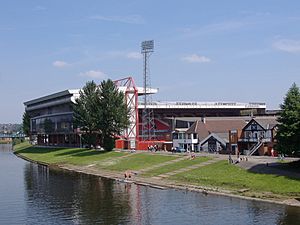
Since 1898, Nottingham Forest has played its home games at the City Ground. It's located in West Bridgford, right next to the River Trent. Before the City Ground, Forest played at other places like Forest Racecourse and Trent Bridge.
The City Ground became an all-seater stadium in 1994. This was to get ready for Euro 96, a big football tournament. It can hold 30,445 fans.
The City Ground is very close to Notts County's stadium, Meadow Lane. They are the two closest professional football stadiums in England. The City Ground got its name because it was inside Nottingham city limits in 1898. Now, it's just outside the city.
Nottingham Forest plans to make the City Ground even bigger. They want to build a new stand and increase the capacity to 38,000 seats. This would make it the largest football stadium in the East Midlands.
Ground History
| Period | Ground | Location |
|---|---|---|
| 1865–78 | Forest Recreation Ground | Forest Fields |
| 1879–80 | Castle Ground | The Meadows |
| 1880–82 | Trent Bridge Cricket Ground | West Bridgford |
| 1882–85 | Parkside Ground | Lenton |
| 1885–90 | Gregory Ground | Lenton |
| 1890–98 | Town Ground | The Meadows |
| 1898– | City Ground | West Bridgford |
Rivals and Supporters
Even though Notts County is geographically the closest club, Forest's biggest rival is Derby County. Their rivalry started way back in the 1898 FA Cup Final, when Forest surprisingly beat Derby.
Their matches are known as the East Midlands derby. Since 2007, the winner of this derby gets the Brian Clough Trophy. Forest currently holds this trophy.
Forest also has rivalries with Leicester City and Sheffield United. The rivalry with Sheffield United grew stronger after some intense play-off matches in 2003 and 2022.
Managers
This table shows all managers and how many games they played, won, drawn, and lost. Caretaker managers are in italics.
| Number | Manager | From | To | Played | Won | Drawn | Lost | Won % | Drawn % | Lost % |
|---|---|---|---|---|---|---|---|---|---|---|
| 1 | Harry Radford | 1 August 1889 | 31 May 1897 | 176 | 69 | 34 | 73 | 39.2% | 19.3% | 41.5% |
| 2 | Harry Hallam | 1 August 1897 | 31 May 1909 | 462 | 188 | 104 | 170 | 40.7% | 22.5% | 36.8% |
| 3 | 1 August 1909 | 31 May 1912 | 120 | 35 | 26 | 59 | 29.2% | 21.7% | 49.2% | |
| 4 | Bob Masters | 1 August 1912 | 31 May 1925 | 385 | 108 | 97 | 180 | 28.1% | 25.2% | 46.8% |
| 5 | John Baynes | 1 August 1925 | 31 May 1929 | 182 | 69 | 47 | 66 | 37.9% | 25.8% | 36.3% |
| 6 | 1 August 1930 | 31 May 1931 | 43 | 14 | 9 | 20 | 32.6% | 20.9% | 46.5% | |
| 7 | Noel Watson | 1 August 1931 | 31 May 1936 | 223 | 79 | 57 | 87 | 35.4% | 25.6% | 39.0% |
| 8 | 1 August 1936 | 31 May 1939 | 119 | 33 | 27 | 59 | 27.7% | 22.7% | 49.6% | |
| 9 | 1 May 1939 | 1 June 1960 | 650 | 272 | 147 | 231 | 41.8% | 22.6% | 35.5% | |
| 10 | 1 September 1960 | 1 July 1963 | 140 | 52 | 30 | 58 | 37.1% | 21.4% | 41.4% | |
| 11 | 1 July 1963 | 31 December 1968 | 267 | 99 | 65 | 93 | 38.5% | 25.3% | 36.2% | |
| 12 | 1 January 1969 | 20 October 1972 | 177 | 49 | 48 | 80 | 27.7% | 27.1% | 45.2% | |
| 13 | 2 November 1972 | 23 October 1973 | 44 | 13 | 14 | 17 | 29.5% | 31.8% | 38.6% | |
| 14 | 19 November 1973 | 3 January 1975 | 57 | 20 | 17 | 20 | 35.1% | 29.8% | 35.1% | |
| 15 | 3 January 1975 | 8 May 1993 | 968 | 447 | 258 | 263 | 46.2% | 26.7% | 27.2% | |
| 16 | 13 May 1993 | 19 December 1996 | 180 | 73 | 59 | 48 | 40.5% | 32.7% | 26.6% | |
| 17 | 20 December 1996 | 8 May 1997 | 24 | 7 | 9 | 8 | 29.2% | 37.5% | 33.3% | |
| 18 | 8 May 1997 | 5 January 1999 | 76 | 33 | 20 | 23 | 43.4% | 26.3% | 30.2% | |
| 19 | 5 January 1999 | 11 January 1999 | 1 | 0 | 0 | 1 | 0.0% | 0.0% | 100.0% | |
| 20 | 11 January 1999 | 16 May 1999 | 17 | 5 | 2 | 10 | 29.4% | 11.8% | 58.8% | |
| 21 | 1 July 1999 | 12 July 2001 | 103 | 37 | 25 | 41 | 35.9% | 24.3% | 39.8% | |
| 22 | 12 July 2001 | 7 February 2004 | 135 | 42 | 44 | 49 | 31.1% | 32.6% | 36.3% | |
| 23 | 10 February 2004 | 16 December 2004 | 44 | 15 | 15 | 14 | 34.1% | 34.1% | 31.8% | |
| 24 | 16 December 2004 | 10 January 2005 | 6 | 2 | 1 | 3 | 33.3% | 16.7% | 50.0% | |
| 25 | 10 January 2005 | 16 February 2006 | 59 | 17 | 18 | 24 | 28.8% | 30.5% | 40.7% | |
| 26 | 17 February 2006 | 30 May 2006 | 13 | 8 | 4 | 1 | 61.5% | 30.8% | 7.7% | |
| 27 | 30 May 2006 | 26 December 2008 | 136 | 57 | 42 | 37 | 41.9% | 30.9% | 27.2% | |
| 28 | 27 December 2008 | 4 January 2009 | 2 | 2 | 0 | 0 | 100.0% | 0.0% | 0.0% | |
| 29 | 4 January 2009 | 12 June 2011 | 126 | 53 | 36 | 37 | 42.1% | 28.6% | 29.4% | |
| 30 | 13 June 2011 | 2 October 2011 | 13 | 3 | 3 | 7 | 23.1% | 23.1% | 53.8% | |
| 31 | 2 October 2011 | 15 October 2011 | 1 | 0 | 0 | 1 | 0% | 0% | 100% | |
| 32 | 14 October 2011 | 12 July 2012 | 37 | 12 | 7 | 18 | 32.4% | 18.9% | 48.6% | |
| 33 | 20 July 2012 | 26 December 2012 | 26 | 10 | 9 | 7 | 38.5% | 34.6% | 26.9% | |
| 34 | 27 December 2012 | 5 February 2013 | 7 | 1 | 2 | 4 | 14.3% | 28.6% | 57.1% | |
| 35 | 5 February 2013 | 9 February 2013 | 1 | 0 | 0 | 1 | 0% | 0% | 100% | |
| 36 | 7 February 2013 | 24 March 2014 | 59 | 25 | 21 | 13 | 42.3% | 35.6% | 22.0% | |
| 37 | 24 March 2014 | 3 May 2014 | 9 | 2 | 2 | 5 | 22.2% | 22.2% | 55.6% | |
| 38 | 1 July 2014 | 1 February 2015 | 32 | 10 | 10 | 12 | 31.25% | 31.25% | 37.5% | |
| 39 | 1 February 2015 | 13 March 2016 | 57 | 19 | 16 | 22 | 33.3% | 28.1% | 38.6% | |
| 40 | 13 March 2016 | 12 May 2016 | 10 | 2 | 4 | 4 | 20.0% | 40.0% | 40.0% | |
| 41 | 27 June 2016 | 14 January 2017 | 30 | 9 | 6 | 15 | 30.0% | 20.0% | 50.0% | |
| 42 | 14 January 2017 | 14 March 2017 | 11 | 4 | 1 | 6 | 36.4% | 9.1% | 54.5% | |
| 43 | 14 March 2017 | 31 December 2017 | 37 | 15 | 3 | 19 | 40.5% | 8.1% | 51.4% | |
| 44 | 31 December 2017 | 8 January 2018 | 2 | 1 | 1 | 0 | 50.0% | 50.0% | 0.0% | |
| 45 | 8 January 2018 | 11 January 2019 | 51 | 16 | 19 | 16 | 31.4% | 37.2% | 31.4% | |
| 46 | 11 January 2019 | 15 January 2019 | 1 | 0 | 0 | 1 | 0.0% | 0.0% | 100.0% | |
| 47 | 15 January 2019 | 28 June 2019 | 19 | 8 | 3 | 8 | 42.1% | 15.8% | 42.1% | |
| 48 | 28 June 2019 | 6 October 2020 | 55 | 20 | 16 | 19 | 36.4% | 29.1% | 34.5% | |
| 49 | 6 October 2020 | 16 September 2021 | 53 | 14 | 17 | 22 | 26.4% | 32.1% | 41.5% | |
| 50 | 16 September 2021 | 21 September 2021 | 1 | 1 | 0 | 0 | 100.0% | 0.0% | 0.0% | |
| 51 | 21 September 2021 | 19 December 2023 | 108 | 42 | 27 | 39 | 43.3% | 24.5% | 32.2% | |
| 52 | 20 December 2023 | present | 0 | 0 | 0 | 0 | 0% | 0% | 0% |
Club Records
- Most games played: 692 by Bob McKinlay (1951–1970)
- Most goals scored: 217 by Grenville Morris (1898–1913)
- Highest attendance: 49,946 vs. Manchester United on October 28, 1967
- Longest unbeaten league run: 42 games, from November 26, 1977, to November 25, 1978
- Biggest win: 14–0 vs. Clapton in the FA Cup, January 17, 1891
- Biggest defeat: 1–9 vs. Blackburn Rovers, April 10, 1937
- Most league points in a season (3 points for a win): 94 points in 1997–98
- Most league goals in a season: 110 goals in 1950–51
- Highest league scorer in one season: Wally Ardron with 36 goals in 1950–51
- Youngest league player: Craig Westcarr, 16 years old, on October 13, 2001
- Oldest league player: Dave Beasant, 42 years and 47 days old, on May 6, 2001
- Record transfer fee paid: £30,000,000 for Ibrahim Sangaré
- Record transfer fee received: £47,500,000 for Brennan Johnson
European Football Record
| Pos | Competition | Pld | W | D | L | GF | GA | GD | Pts |
|---|---|---|---|---|---|---|---|---|---|
| 1 | European Cup | 20 | 12 | 4 | 4 | 32 | 14 | +18 | 40 |
| 2 | UEFA Cup | 20 | 10 | 5 | 5 | 18 | 16 | +2 | 35 |
| 3 | Inter-Cities Fairs Cup | 6 | 3 | 0 | 3 | 8 | 9 | −1 | 9 |
| 4 | European Super Cup | 4 | 2 | 1 | 1 | 4 | 3 | +1 | 7 |
| 5 | Intercontinental Cup | 1 | 0 | 0 | 1 | 0 | 1 | −1 | 0 |
| Season | Competition | Round | Opponent | Home | Away | Aggregate |
|---|---|---|---|---|---|---|
| 1961–62 | Inter-Cities Fairs Cup | First round | 1–5 | 0–2 | 1–7 | |
| 1967–68 | Inter-Cities Fairs Cup | First round | 4–0 | 1–0 | 5–0 | |
| Second round | 2–1 | 0–1 | 2–2 (A) | |||
| 1978–79 | European Cup | First round | 2–0 | 0–0 | 2–0 | |
| Second round | 5–1 | 2–1 | 7–2 | |||
| Quarter-final | 4–1 | 1–1 | 5–2 | |||
| Semi-final | 3–3 | 1–0 | 4–3 | |||
| Final | 1–0 | |||||
| 1979 | European Super Cup | 1–0 | 1–1 | 2–1 | ||
| 1979–80 | European Cup | First round | 2–0 | 1–1 | 3–1 | |
| Second round | 2–0 | 2–1 | 4–1 | |||
| Quarter-final | 0–1 | 3–1 | 3–2 | |||
| Semi-final | 2–0 | 0–1 | 2–1 | |||
| Final | 1–0 | |||||
| 1980 | European Super Cup | 2–1 | 0–1 | 2–2 (A) | ||
| 1980 | Intercontinental Cup | 0–1 | ||||
| 1980–81 | European Cup | First round | 0–1 | 0–1 | 0–2 | |
| 1983–84 | UEFA Cup | First round | 2–0 | 1–0 | 3–0 | |
| Second round | 1–0 | 2–1 | 3–1 | |||
| Third round | 0–0 | 2–1 | 2–1 | |||
| Quarter-final | 1–0 | 1–1 | 2–1 | |||
| Semi-final | 2–0 | 0–3 | 2–3 | |||
| 1984–85 | UEFA Cup | First round | 0–0 | 0–1 | 0–1 | |
| 1995–96 | UEFA Cup | First round | 1–0 | 1–2 | 2–2 (A) | |
| Second round | 0–0 | 1–0 | 1–0 | |||
| Third round | 1–0 | 0–0 | 1–0 | |||
| Quarter-final | 1–5 | 1–2 | 2–7 | |||
Players
First-Team Squad
|
|
Unregistered Players
|
|
Players on Loan
|
|
Club Staff
Coaching Staff
| Role | Name |
|---|---|
| Manager | |
| Assistant manager | |
| Assistant manager | |
| First team coach | |
| First team coach | |
| Fitnesss coach | |
| First team goalkeeper coach | |
| Head of performance analysis | |
| Set piece coach | |
| Head video analyst | |
| Video analyst | |
| Head of performance | |
| Head of strength & conditioning | |
| Head of medical & sports doctor | |
| Physio | |
| Physio |
Executive Staff
| Role | Name |
|---|---|
| Majority owner | |
| Minority owner | |
| Chairman | |
| Director | |
| Director | |
| Director | |
| Director | |
| Chief football officer | |
| Head of football administration | |
| Head of football operations | |
| Head of football development | |
| Head of academy recruitment | |
| Recruitment operations manager | |
| Chief operating officer | |
| Chief commercial officer | |
| Finance director | |
| Director of communications |
Famous Former Players
Player of the Season
All-Time Best XI (Team)
In 1997 and 1998, fans voted for the club's official All-Time Best Team.
| Position | Player | Years at club |
|---|---|---|
| GK | 1977–82 | |
| RB | 1974–84 | |
| RCB | 1984–92; 2002–04 | |
| LCB | 1977–81 | |
| LB | 1985–97 | |
| RCM | 1971–81 | |
| ACM | 1990–93 | |
| LCM | 1977–79 | |
| RW | 1962–72 | |
| CF | 1979–81 | |
| LW | 1970–83; 1985–86 |
In 2016, for the club's 150th anniversary, season ticket holders also voted for their greatest eleven.
| Position | Player | Years at club |
|---|---|---|
| GK | 1977–82 | |
| RB | 1974–83 | |
| CB | 1977–81 | |
| CB | 1983–04 | |
| LB | 1985–97 | |
| RW | 1971–81 | |
| CM | 1990–93 | |
| CM | 1974–81 | |
| LW | 1970–83 | |
| ST | 1993–95 | |
| ST | 1962–72 |
International Players
Trophies and Achievements
Domestic Competitions
League Titles
- First Division (top league)
- Winners: 1977–78
- Second Place: 1966–67, 1978–79
- Second Division / First Division / Championship (second league)
- Winners: 1906–07, 1921–22, 1997–98
- Second Place: 1956–57, 1993–94
- Promoted: 1976–77
- Play-off Winners: 2022
- Third Division South / League One (third league)
- Winners: 1950–51
- Second Place: 2007–08
- Football Alliance
- Winners: 1891–92
Cup Competitions
- FA Cup
- Winners: 1897–98, 1958–59
- Runners-up: 1990–91
- Football League Cup
- Winners: 1977–78, 1978–79, 1988–89, 1989–90
- Runners-up: 1979–80, 1991–92
- FA Charity Shield
- Winners: 1978
- Runners-up: 1959
- Full Members' Cup
- Winners: 1988–89, 1991–92
European Competitions
- European Cup
- Winners: 1978–79, 1979–80
- European Super Cup
- Winners: 1979
- Runners-up: 1980
- Intercontinental Cup
- Runners-up: 1980
Other Titles
- Anglo-Scottish Cup
- Winners: 1977
- Football League Centenary Tournament
- Winners: 1988
Other Nottingham Forest Teams
- Nottingham Forest Women
- Nottingham Forest Under-21s
- Nottingham Forest Under-18s
- Nottingham Forest Academy
See also
 In Spanish: Nottingham Forest Football Club para niños
In Spanish: Nottingham Forest Football Club para niños



